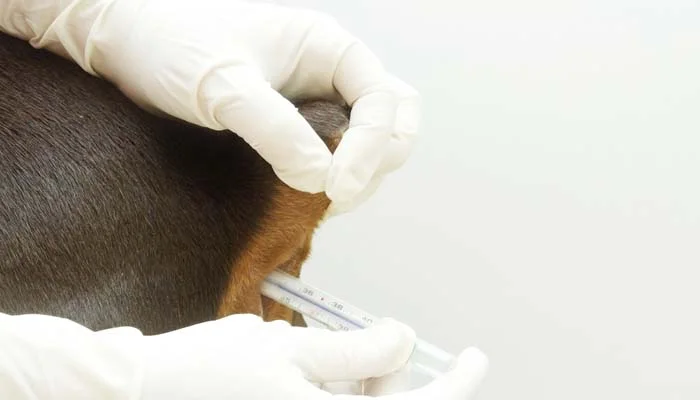High Fever in Dogs: If your dog is exhibiting signs of high fever, such as excessive panting, shivering, and difficulty walking or standing, take her to the veterinarian immediately.
There are many potential causes of a fever in dogs, and immediate care is necessary to determine the cause and administer the correct treatment.
Here are some of the most common causes of high fever in dogs:
- Infection: The most common infection that causes a fever in dogs is canine distemper. This virus can cause a high fever, vomiting, diarrhea, and seizures.
- Allergies: Dogs can also develop a fever as a result of an allergic response.
- Others: Some common causes of high fever in dogs include: Autoimmune diseases, cancer, and poisoning. Diagnosing the cause of your dog’s fever is essential for treating it and preventing further complications.
Normal Temperature VS High Fever in Dogs
The regular temperature of a dog’s body can range from 101 to 102.5 degrees Fahrenheit, which is quite hotter than the typical temperature of a human body (97.6 to 99.6 F).
Also Read: Why Isn’t My Male Dog Interested In Mating?
Your canine companion shows the symptoms of fever if its temperature is higher than 103 degrees Fahrenheit. When a dog’s temperature hits 106 degrees Fahrenheit, it is considered to have an extremely high temperature and is at risk of developing significant problems and maybe even deadly problems.
Taking Your Dog’s Temperature
Because dogs’ core temperatures can spike in response to stress or excitement, diagnosing a fever in them can be tricky. Body temperatures fluctuate throughout the day and night in dogs, too. Keeping track of your dog’s temperature throughout the day and night will help you identify if he or she is in a healthy state or if he or temperature is rising.
A common misunderstanding is that if you feel your dog’s nose and its wet and cold, it signifies that your dog has a normal temperature, while if it’s hot and dry; it indicates that your dog has a fever. This, however, is not a reliable sign that your dog is suffering from a fever.
Using a digital rectal thermometer is the most accurate way to check your dog’s temperature, and some pet stores provide thermometers specifically for pets. Keeping a dog-specific thermometer in the same location where you keep your dog’s other supplies is a good idea.

Once the thermometer’s tip has been lubricated, move on to the next step. Insert the thermometer about an inch into your dog’s rectum, then raise the dog’s tail and look at it from the side. If you can, get a second person to hold beneath your dog’s hind legs to keep them from sitting down. Remove the thermometer as soon as the temperature is known.
Causes of Fever in Dogs
Many dogs develop fever as a result of a variety of causes, both common and rare.
Some of the more common causes of fever in dogs include infectious diseases, metabolic diseases, and neoplasia.
Rare causes of fever in dogs can include complications from surgery, head trauma, and poison ingestion. In most cases, the cause of fever is eventually diagnosed and treated appropriately.
There are numerous reasons why your dog is suffering from a fever. Some of the most popular are:
- Infection of the tooth or abscess in the tooth
- One of the following: Bacterial, fungal or viral
- An infection of the urinary tract
- A bacterial infection in the ear
- Bite, scratch, or wound that has become infected
- Dogs eating human pharmaceuticals or harmful foods, such as those found in some plants and some human diets.
It’s not always easy to pinpoint the source of your dog’s fever. FUO is the medical term for this type of illness. They may have an underlying immunological illness, cancer, or abnormalities with their bone marrow that are responsible for the fever in these circumstances.
Signs That Your Dog May Have a Fever
There are a few things you can check to see if your dog may be feverish. One is to take the temperature of your dog. If it is over 103 degrees Fahrenheit, take your dog to the veterinarian immediately. Other signs that your dog may have a fever include:
- A reduction or absence of appetite
- Shivering
- Panting
- Eyes that have a crimson or glazed appearance
- Warm either the ears or the nose
- Runny nose
- Reduced vitality
- Coughing
- Vomiting
How to Reduce Fever in Dogs
One of the most common complaints from dog owners is their dog’s fever. While it can be frustrating to see your pup panting and shaking uncontrollably, there are a few things you can do to reduce your dog’s fever.
The following tips will help keep your pet cool and comfortable during a fever:
- Keep them hydrated. Dehydration is one of the most common causes of fever in dogs and can make the symptoms worse. Make sure they have plenty of fresh water and avoid giving them ice or cold drinks.
- Increase their activity level. A tired dog is less likely to get sick, so encourage them to move around by playing games, running or taking them on walks.
- Cover them up. When it’s hot outside, keep your pup inside where it’s cooler and cover them with a blanket or towel.
Be sure to keep an eye on your dog and check on them frequently to make sure they don’t get a fever again.
If you want your dog to stay hydrated, you should try to get it to drink a little bit of water every now and then, but you shouldn’t force it to drink.
It is vital that you do not give your dog any human pharmaceuticals like ibuprofen or other pain relievers. If your dog were to consume one of these medications, it might result in the animal’s death or in serious damage.
If your dog displays any other symptoms, like shaking, panting, or vomiting, you want to think about taking him to the veterinarian as soon as possible.
Over the counter medicines for high fever in dogs
Oftentimes when a dog has a high fever, they will need to take over the counter medicines to relieve their symptoms. Over the counter medications can be found in many pet stores and include ibuprofen, acetaminophen, and aspirin. These medications should only be given to dogs if their fever is above 101 degrees Fahrenheit, as taking them excessively can cause liver damage.
Conclusion
If your dog has a fever, take them to the vet as soon as possible for a proper diagnosis and treatment. If your dog has a high fever, do not give them anything to eat or drink, and keep them cool and comfortable. Place a fan in their room to help circulate air, and use a humidifier if needed. If your dog seems to be in pain, give them medication prescribed by the veterinarian.

